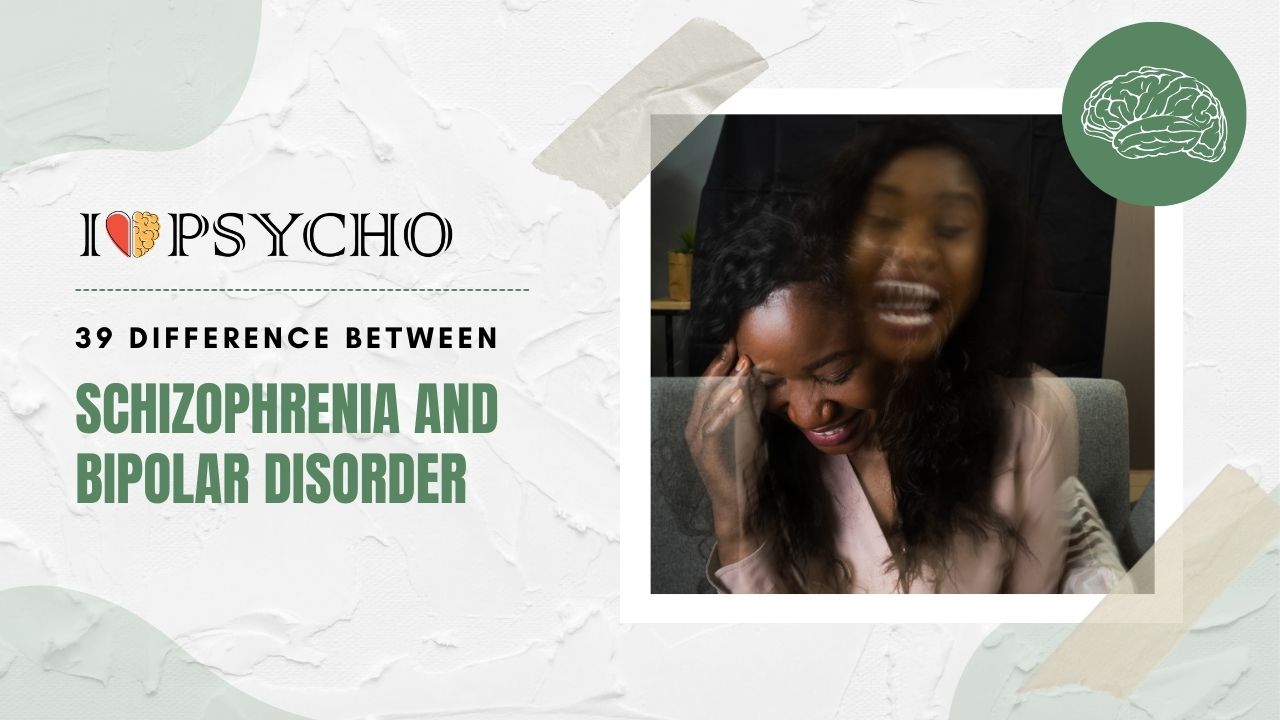Mental health diseases like schizophrenia and bipolar disorder have different symptoms and diagnostic criteria. While both can severely hinder a person’s life, they vary in numerous ways.
Thought, emotion, and sensory abnormalities characterize schizophrenia, a persistent psychotic illness. Hallucinations, delusions, and disorganization are common in schizophrenia. Their world might be severely disrupted by these symptoms, making it hard for them to tell the difference. In schizophrenia, cognitive impairment and social disengagement are prevalent. Antipsychotics and psychotherapy are needed for lifetime treatment, which usually begins in late adolescence or early adulthood.
In contrast, bipolar disorder is characterized by significant mood fluctuations. It has manic and depressed stages. Mania can cause energy, impulsivity, poor sleep, grandiose views, and risk-taking. In contrast, depressive periods cause poor energy, unhappiness, sleep and appetite problems, and worthlessness. Bipolar disorder patients show significant stability between mood episodes, unlike schizophrenia. The onset usually occurs in late adolescence or early adulthood. Psychotherapy, mood stabilizers, and antipsychotics are typically prescribed.
Another difference is the illnesses’ nature. Bipolar disorder involves mood swings, whereas schizophrenia disrupts perception and mental processes, causing reality distortions. Misdiagnosis can arise because both conditions have symptoms like psychosis but in different situations.
The prognosis and treatment methods vary. Lifelong treatment is needed for schizophrenia to prevent relapses, however, mood swings can be stabilized with medication for bipolar illness. Schizophrenia therapy focuses on cognitive deficiencies and social skills, whereas bipolar disorder therapy focuses on mood management and coping methods. Both disorders require therapy and support.
Finally, schizophrenia and bipolar illness have different symptoms, onset patterns, and treatments. Correct diagnosis and treatment are crucial since various ailments are managed differently, and a mistake can lead to insufficient care and worsening outcomes for those with these difficult disorders.
|
S.No. |
Aspect |
Schizophrenia |
Bipolar Disorder |
|
1 |
Primary Diagnosis |
Psychotic disorder |
Mood disorder |
|
2 |
Core Symptoms |
Delusions, hallucinations |
Mood swings |
|
3 |
Onset Age |
Typically late teens to early 30s |
Late teens to early 20s |
|
4 |
Nature of Symptoms |
Distorted perception of reality |
Altered mood states |
|
5 |
Duration of Symptoms |
Chronic (often lifelong) |
Episodic |
|
6 |
Cognitive Impairment |
Common, including disorganized thinking |
Less pronounced |
|
7 |
Emotional States |
Emotionally flat or blunted |
Intense emotional states |
|
8 |
Mania or Hypomania |
Not a characteristic feature |
Central feature |
|
9 |
Depressive Episodes |
Less common, not defining |
Defining feature |
|
10 |
Thought Disorders |
Prominent, e.g., thought broadcasting |
Less pronounced |
|
11 |
Mood Stability |
Generally stable mood |
Mood instability |
|
12 |
Medication for Stabilization |
Antipsychotics |
Mood stabilizers |
|
13 |
Hallucinations |
Auditory and visual hallucinations |
Not typical |
|
14 |
Delusions |
Often paranoid or bizarre |
Not characteristic |
|
15 |
Social Functioning |
Impaired, difficulty in relationships |
Impaired during episodes |
|
16 |
Genetic Component |
Moderate hereditary risk |
Strong genetic component |
|
17 |
Prodromal Phase |
Often observed before onset |
Less pronounced |
|
18 |
Euphoria |
Rarely present |
Common in mania |
|
19 |
Suicidal Tendencies |
Higher risk, especially early on |
Elevated risk during depressive episodes |
|
20 |
Treatment Approach |
Focused on antipsychotic medications |
Mood stabilizers and therapy |
|
21 |
Family History |
May or may not have a family history |
Often family history of mood disorders |
|
22 |
Neurotransmitter Imbalance |
Dysregulation of dopamine |
Dysregulation of serotonin, norepinephrine |
|
23 |
Hallucination Content |
Often persecutory or commanding |
N/A |
|
24 |
Hallucination Frequency |
Frequent and persistent |
N/A |
|
25 |
Bipolar Subtypes |
Not applicable |
Bipolar I, Bipolar II, Cyclothymic Disorder |
|
26 |
Response to Antipsychotics |
Often effective |
May worsen mood |
|
27 |
Response to Mood Stabilizers |
Less effective |
Effective |
|
28 |
Cognitive Functioning |
Impaired, especially during episodes |
Impaired during manic episodes |
|
29 |
Sleep Patterns |
Often disrupted |
Altered during manic and depressive phases |
|
30 |
Reality Testing |
Impaired, difficulty distinguishing delusions from reality |
Generally intact |
|
31 |
Medication Adherence |
May be challenging due to side effects |
Variable |
|
32 |
Neuropsychological Impairments |
Common, including deficits in attention and memory |
Less pronounced |
|
33 |
Psychosis vs. Mood Episodes |
Dominant feature is psychosis |
Dominant feature is mood disturbance |
|
34 |
Brain Imaging Findings |
Structural and functional abnormalities |
Functional abnormalities during mood episodes |
|
35 |
Comorbid Conditions |
Substance abuse, anxiety disorders |
Anxiety disorders, substance abuse |
|
36 |
Relapse Patterns |
Frequent relapses and remissions |
Episodic, less frequent relapses |
|
37 |
Impact on Daily Life |
Severe impairment in daily functioning |
Variable, depending on mood state |
|
38 |
Suicidal Behavior |
Higher risk, especially during psychotic episodes |
Elevated risk during depressive episodes |
|
39 |
Prognosis |
Variable, often chronic with periods of stability |
Episodic with periods of remission |
Frequently Asked Questions (FAQs)
Q1: What are the main schizophrenia and bipolar disorder differences?
Schizophrenia and bipolar illness are fundamentally different. In schizophrenia, mental processes and perception are affected, causing hallucinations, delusions, and disorganized thinking. Bipolar disorder, on the other hand, causes mood changes, including manic and depressed episodes. Schizophrenia’s psychosis is persistent, while bipolar disorder’s is episodic.
Q2: How do the two illnesses differ in onset and age of diagnosis?
Schizophrenia symptoms gradually appear in late adolescence or early adulthood. The syndrome is usually lifelong. Bipolar disorder, which commonly starts in late adolescence or early adulthood, has mood swings and intervals of stability. Bipolar illness mood fluctuations can mimic schizophrenia mood swings, making diagnosis difficult.
Q3: What treatments are available for these disorders?
Schizophrenia treatment usually requires long-term antipsychotics and psychotherapy. Therapy targets cognitive and social abilities. Bipolar disorder is treated with mood stabilizers like lithium or anticonvulsants and mood management and coping psychotherapy. Prevention and management of mood swings are provided through medications and counseling. Personal needs and experiences typically determine the therapy strategy.
Q4: Can schizophrenia coexist with bipolar disorder?
Yes, schizophrenia and bipolar illness may coexist, although it’s unusual. Schizoaffective disorder includes both conditions. Schizoaffective illness causes manic or depressed mood episodes and psychotic symptoms including hallucinations and delusions. Treatment must address mood stabilization and psychosis control, thus accurate diagnosis is essential.
Q5: What is the long-term prognosis for these conditions?
Since schizophrenia requires lifetime care, its long-term outlook is difficult. Many schizophrenia patients can achieve symptom remission and live full lives with therapy and care. Although chronic, bipolar disorder has a better long-term prognosis. Bipolar illness patients can live productively with lower relapse rates with proper medication and counseling.









